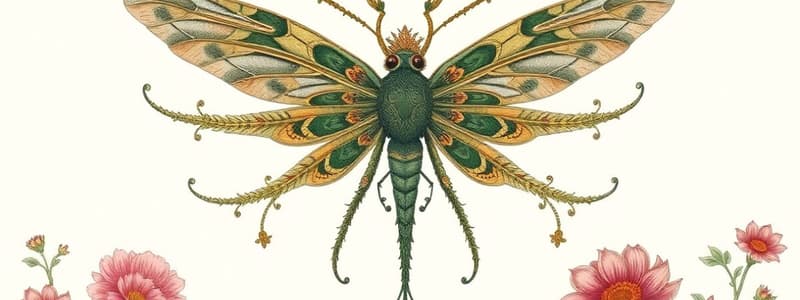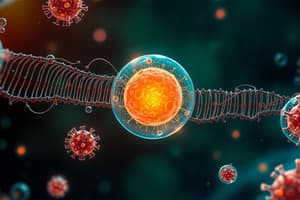Podcast
Questions and Answers
What are the seven classifications of living organisms according to Linnaeus?
What are the seven classifications of living organisms according to Linnaeus?
- Kingdom, Phylum, Class, Order, Family, Genus, Species (correct)
- Kingdom, Phylum, Class, Order, Family, Genus, Race
- Domain, Kingdom, Phylum, Class, Order, Family, Genus
Which of the following are characteristics of the animal kingdom?
Which of the following are characteristics of the animal kingdom?
- Multicellular, autotrophs, asexual reproduction
- Unicellular, heterotrophs, sexual reproduction
- Multicellular, heterotrophs, sexual reproduction (correct)
- Filamentous, heterotrophs, sexual and asexual reproduction
Which of the following are characteristics of the plant kingdom?
Which of the following are characteristics of the plant kingdom?
- Multicellular, heterotrophs, sexual reproduction
- Filamentous, heterotrophs, sexual and asexual reproduction
- Multicellular, autotrophs, asexual reproduction (correct)
- Unicellular, heterotrophs, sexual reproduction
Which of the following are characteristics of the Eubacteria kingdom?
Which of the following are characteristics of the Eubacteria kingdom?
Which of the following are characteristics of the Protista kingdom?
Which of the following are characteristics of the Protista kingdom?
Which of the following are considered main phyla?
Which of the following are considered main phyla?
How is the scientific name of an organism written?
How is the scientific name of an organism written?
What are viruses considered?
What are viruses considered?
List three common virus diseases.
List three common virus diseases.
What is the main outcome of the lytic cycle?
What is the main outcome of the lytic cycle?
Prokaryotes have membrane-bound organelles.
Prokaryotes have membrane-bound organelles.
Eukaryotes have a true nucleus.
Eukaryotes have a true nucleus.
What is antibiotic resistance?
What is antibiotic resistance?
What is Clostridium difficile and what are some factors that can increase risk?
What is Clostridium difficile and what are some factors that can increase risk?
What are some prevention methods for Clostridium difficile?
What are some prevention methods for Clostridium difficile?
How are plant-like protists important to all life on Earth?
How are plant-like protists important to all life on Earth?
Describe the life cycle of a typical fungus
Describe the life cycle of a typical fungus
What role do fungi play in ecosystems?
What role do fungi play in ecosystems?
What are two common traits that all arthropods share?
What are two common traits that all arthropods share?
What is the difference between the digestive systems of sponges and earthworms?
What is the difference between the digestive systems of sponges and earthworms?
Which classification of fish does the great white shark belong to?
Which classification of fish does the great white shark belong to?
What are three characteristics of mammals?
What are three characteristics of mammals?
Which type of symmetry does a starfish have?
Which type of symmetry does a starfish have?
What is bilateral symmetry?
What is bilateral symmetry?
Why was the evolution of the amnion an important adaptation for egg-layers?
Why was the evolution of the amnion an important adaptation for egg-layers?
Flashcards
Linnaeus's Ranks
Linnaeus's Ranks
The hierarchical system of classifying organisms from broadest to most specific, including Kingdom, Phylum, Class, Order, Family, Genus, and Species.
Species
Species
A group of organisms with similar characteristics that can interbreed and produce fertile offspring.
Genus
Genus
A group of closely related species.
Taxonomy
Taxonomy
Signup and view all the flashcards
Phylogeny
Phylogeny
Signup and view all the flashcards
Clade
Clade
Signup and view all the flashcards
Phylogenetic Tree
Phylogenetic Tree
Signup and view all the flashcards
Evolution
Evolution
Signup and view all the flashcards
Natural Selection
Natural Selection
Signup and view all the flashcards
Fitness
Fitness
Signup and view all the flashcards
Homologous Structures
Homologous Structures
Signup and view all the flashcards
Analogous Structures
Analogous Structures
Signup and view all the flashcards
Biogeography
Biogeography
Signup and view all the flashcards
Biodiversity
Biodiversity
Signup and view all the flashcards
Adaptation
Adaptation
Signup and view all the flashcards
Divergence
Divergence
Signup and view all the flashcards
Convergence
Convergence
Signup and view all the flashcards
Complexity
Complexity
Signup and view all the flashcards
Specialization
Specialization
Signup and view all the flashcards
Monophyletic Group
Monophyletic Group
Signup and view all the flashcards
Phylogenetic Classification
Phylogenetic Classification
Signup and view all the flashcards
Phenetic Classification
Phenetic Classification
Signup and view all the flashcards
Ecology
Ecology
Signup and view all the flashcards
Niche
Niche
Signup and view all the flashcards
Population
Population
Signup and view all the flashcards
Community
Community
Signup and view all the flashcards
Ecosystem
Ecosystem
Signup and view all the flashcards
Biome
Biome
Signup and view all the flashcards
Biomass
Biomass
Signup and view all the flashcards
Energy Flow
Energy Flow
Signup and view all the flashcards
Biogeochemical Cycles
Biogeochemical Cycles
Signup and view all the flashcards
Environmental Science
Environmental Science
Signup and view all the flashcards
Study Notes
Classification and Diversity of Living Things
-
Linnaean Classification: A hierarchical system (Kingdom, Phylum, Class, Order, Family, Genus, Species) that arranges organisms from general to specific.
-
Kingdoms:
-
Animalia: Multicellular, heterotrophic, sexual reproduction.
-
Plantae: Multicellular, autotrophic, often asexual.
-
Fungi: Filamentous, heterotrophic, both sexual and asexual.
-
Eubacteria: Unicellular, autotrophic or heterotrophic, reproduce through binary fission.
-
Archaea: Unicellular, autotrophic or heterotrophic, asexual reproduction.
-
Protista: Multicellular or unicellular, heterotrophic or autotrophic, sexual or asexual.
Major Phyla Examples
- Arthropoda (e.g., insects), Nematoda (roundworms), Annelida (segmented worms), Mollusca (snails), Rotifera (rotifers), Platyhelminthes (flatworms).
Scientific Names
- Organisms are given two-part names: Genus species (e.g., Canis familiaris).
Viruses
- Viruses are not considered living organisms; they are infectious agents consisting of nucleic acid (DNA or RNA) enclosed in a protein coat.
- Viruses need a host cell to reproduce and cannot produce energy on their own.
- Viruses cause various diseases (e.g., COVID-19, influenza). Precautions can reduce transmission.
Viral Replication: Lytic and Lysogenic Cycles
- Lytic Cycle: The virus rapidly replicates, destroys the host cell, and releases new viruses to infect other cells.
- Lysogenic Cycle: The viral DNA integrates into the host cell's DNA and replicates along with it. The virus remains dormant for some time before activating and entering the lytic cycle.
Prokaryotes vs. Eukaryotes
- Prokaryotes: Lack a true nucleus, membrane-bound organelles, and have a single circular chromosome in the nucleoid.
- Eukaryotes: Possess a true nucleus and membrane-bound organelles, have multiple linear chromosomes in the nucleus.
Antibiotic Resistance
- Bacteria can develop resistance to antibiotics, making them harder to treat.
Clostridium difficile
- A bacterium that can cause severe diarrhea and inflammation of the colon (colitis).
- Risk factors include certain antibiotics and age.
- Treatment options include FMT, probiotics, and in severe cases, surgery.
Protists and Their Importance
- Protists (plant-like protists):
- Essential producers of oxygen in many ecosystems.
- Serve as a base of the food web.
- Important for carbon cycling (absorbing CO2).
Fungi
- Fungi play a vital role in decomposition, nutrient cycling, and supporting plant growth.
- They are crucial decomposers.
- Their life cycle may involve diploid, haploid, and dikaryotic stages, typically progressing from spore germination to fruiting body formation.
Characteristics of Plants and Arthropods
- Arthropods: All arthropods share an exoskeleton made of chitin and segmented bodies with jointed appendages.
- Plants: Characteristics vary widely among plant groups.
Animal Body Systems (Sponge and Earthworm)
- Sponge: Intracellular digestion and filter feeding; waste removal by diffusion.
- Earthworm: Complete digestive system; ingestion, digestion, absorption, and egestion through the mouth and anus.
Fish Classifications
- Agnatha: Jawless fish (e.g., lampreys)
- Chondrichthyes: Cartilaginous fish (e.g., sharks).
- Osteichthyes: Bony fish (e.g., goldfish).
Mammals
- Mammals are endothermic (warm-blooded), have hair or fur, and nourish their young with milk from mammary glands.
Symmetry
- Radial Symmetry: Body parts arranged around a central axis (starfish).
- Bilateral Symmetry: Body parts arranged on opposite sides of a central axis (humans, crabs).
Amnion Adaptation
- The amnion is an important adaptation for egg-laying animals as it provides protection, prevents desiccation, and allows larger embryonic development.
Studying That Suits You
Use AI to generate personalized quizzes and flashcards to suit your learning preferences.




